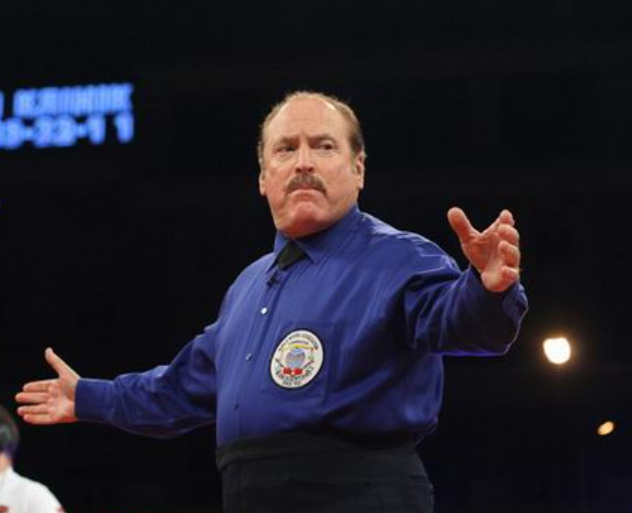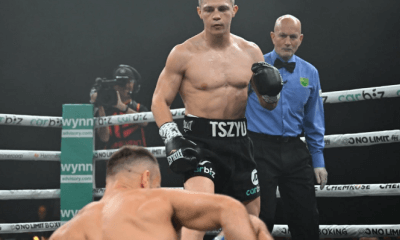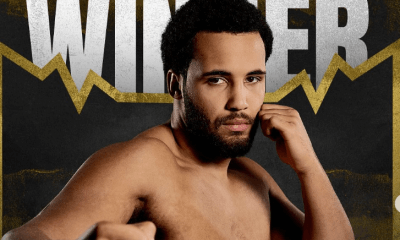Featured Articles
R.I.P. Steve ‘Double-S’ Smoger, Boxing’s Most-Traveled Referee

If referees boogied toward the ring to the sound of their own entrance music, as all reasonably relevant fighters do now, the logical guess is that referee Steve “Double-S” Smoger’s signature song would be Ricky Nelson’s 1961 hit, Travelin’ Man. Whether he was the third man in the ring for 185 or 200-plus world championship bouts (both figures have been cited for historical purposes) spread over 34 years, the Atlantic City-based Smoger liked to point out he was the referee whose passport was the most-stamped ever for those in his profession, with many U.S. states also on his long list of visited places whereby he could break clinches.
“I like to work, wherever and whenever,” the mustachioed Smoger, who passed away Monday (Dec. 19) after a long illness, once told me of his wanderlust, or all-encompassing career dedication, however one might choose to describe his paid appearances on five continents and countless cities therein where he informed fighters to adhere to his inalterable set of rules, in an emphatic enough manner that somehow never got lost in translation.
“It had to help,” Larry Hazzard, longtime head of the New Jersey State Board of Athletic Control, said of Smoger’s penchant for remaining basically the same high-grade professional whether he was working a show where the customs and customers might be far different from what he was used to as a young ref learning the ropes, as it were. “Variety is certainly a very important aspect of anyone’s learning. The varied experiences you have just give you more tools in your tool box. If you work only in one environment you might be good in that setting, but if something happens that’s kind of outside the norm, you might not be equipped to handle it.
“The more work that officials can get, the better you expect them to be. The mother of retention is repetition. Smoger, in my opinion, was a very good referee and through the years he was always receptive to constructive criticism. I think that’s what made him even better.”
Like the precise number of boxing matches he officiated, more than 1,000 all told, the matter of “Double-S’s” age also might be a matter of some debate. Various sources, including Wikipedia, cite his date of birth as Aug. 15, 1950, in Norfolk, Va., which would make him 72 at his time of death in Atlantic City. But Hazzard, a stickler for accuracy in all fight-related matters, notified Henry Hascup, president of the New Jersey Boxing Hall of Fame who keeps track of all deaths involving boxing figures of all stripes, that Ancestry.com lists Smoger as having made his entrance into the world on Aug. 15, 1943, which would make him 79 for his departure date. That figure seemingly is confirmed by Hascup, who was able to track down a high school yearbook photo of Smoger as a senior in 1961.
At whatever age, however, Smoger, seemingly was predestined to become embroiled in a lifelong love affair with the pugilistic arts. He often spoke of watching fights on the old Gillette Cavalcade of Sports Friday Night Fights with his father, a rite of passage for many kids in post-World War II America, and how much it meant to him for dad and son to travel together to Philadelphia for the Sept. 23, 1952, heavyweight championship pairing in which Jersey Joe Walcott yielded his title to Rocky Marciano on a 13th-round knockout. Somewhat ironically, it was Jersey Joe, then commissioner of the NJSACB, who issued Smoger his first referee’s license 30 years later, in 1982, when he was 32, or maybe 39.
Some might say that Smoger was a bit of a self-promoter, but a bit of flair can help to elevate otherwise competent referees above those whose demeanor, if overly bland, do little to designate this or that fight as a major event. Smoger’s giddy donning of his “Double-S” persona was hardly different from the “Let’s get it on!” catchphrase of another internationally known referee, Mills Lane, who was 85 when he passed away earlier this month, or the “I’m firm but I’m fair” Joe Cortez.
“Steve probably was popular enough to have had fans of his own,” said Alan Rubinstein, a Senior Court Judge in Bucks County, Pennsylvania, in addition to being a boxing judge who observed Smoger’s work from ringside on numerous occasions. “Most referees don’t have aficionados. But Steve Smoger was `Double-S,’ and he received, if not international attention (he did), then national attention. He was sort of the fair-haired darling of HBO when he refereed fights for Boxing After Dark. They always talked, on those broadcasts, about what a great ref he was.”
The flip side, of course, is that a referee can be excoriated if he has a bad night, even permanently so if that person has too many of them. The proof is in the pudding of how well Smoger did his job; he was enshrined in the International Boxing Hall of Fame in the Non-Participant category in 2015, in addition to also being elected to the New Jersey, Pennsylvania and Atlantic City Boxing Halls of Fame. Honors such as those don’t flow so freely and frequently to anyone whose only distinguishing characteristic is a bit of shtick.
It should be noted that Smoger did have a life beyond the ring, and at which he also made a mark. He served as a member of the New Jersey Air National Guard and the United States Air Force Reserve, holding the position of Staff Judge Advocate and obtaining the rank of colonel until he retired after 30 years of service. At all times, however, he never considered his boxing duties to be a hobby or a side gig.
“Steve and I had an ancillary connection,” Rubinstein noted. “He was a district magistrate in New Jersey and I’m a judge in Pennsylvania, so we had a common interest. I remember he said to me years ago that there was allegedly a conflict between his duties as a magistrate and his duties as a boxing referee, although I didn’t see it. To me, it would have been clear that I’d have to give up boxing because I wanted to stay on the bench. He did just the opposite. He gave up his magisterial job so he could continue to be a referee. He was given a choice, and he made the choice I don’t think I would have made.”
Being a district magistrate in Jersey, however, wasn’t likely to keep Smoger’s passport book inked to a fare-thee-well. I remember how excited he was to describe what he said was his first major overseas refereeing assignment, which pitted Simon Brown against Tyrone Trice for the vacant IBF welterweight championship on April 22, 1988, in Berck-Sur-Mer, France, not far from where the greatest amphibious landings in the annals of warfare took place on June 6, 1944, on the beaches of Normandy. Brown and Trice waged a reasonable facsimile of the celebrated welterweight unification showdown of Sugar Ray Leonard and Thomas Hearns, Brown finally emerging victorious on a 14th-round stoppage.
Smoger, the military man part of him, was honored to work a fight so close to the Longest Day beginning of the end of World War II in the European theater, but also to work a great boxing match that was a microcosm of all that the sport sometimes can be.
“What I remember is the resiliency of those guys,” Smoger told me, as excited to remember what had been as he was to work any of the countless other fights he considered to be such an integral part of his own identity. “Simon knocked down Tyrone, what, three times in the 12th, and Tyrone never fully recuperated. Still, he was able to give a credible account of himself until the stoppage in the 14th.”
It is now time for the traditional 10-count bell for the man who forever will be known as “Double-S.”
Bernard Fernandez, named to the International Boxing Hall of Fame in the Observer category with the Class of 2020, was the recipient of numerous awards for writing excellence during his 28-year career as a sports writer for the Philadelphia Daily News. Fernandez’s first book, “Championship Rounds,” a compendium of previously published material, was released in May of last year. The sequel, “Championship Rounds, Round 2,” with a foreword by Jim Lampley, is currently out. His third boxing anthology, “Championship Rounds, Round 3,” is now out and available from Amazon and other book-selling outlets.
To comment on this story in the Fight Forum CLICK HERE
-

 Featured Articles4 weeks ago
Featured Articles4 weeks agoThe Hauser Report: Zayas-Garcia, Pacquiao, Usyk, and the NYSAC
-

 Featured Articles3 weeks ago
Featured Articles3 weeks agoOscar Duarte and Regis Prograis Prevail on an Action-Packed Fight Card in Chicago
-

 Featured Articles2 weeks ago
Featured Articles2 weeks agoThe Hauser Report: Cinematic and Literary Notes
-

 Book Review2 weeks ago
Book Review2 weeks agoMark Kriegel’s New Book About Mike Tyson is a Must-Read
-

 Featured Articles4 weeks ago
Featured Articles4 weeks agoRemembering Dwight Muhammad Qawi (1953-2025) and his Triumphant Return to Prison
-

 Featured Articles1 week ago
Featured Articles1 week agoMoses Itauma Continues his Rapid Rise; Steamrolls Dillian Whyte in Riyadh
-

 Featured Articles3 days ago
Featured Articles3 days agoThe Hauser Report: Debunking Two Myths and Other Notes
-

 Featured Articles3 weeks ago
Featured Articles3 weeks agoRahaman Ali (1943-2025)


















